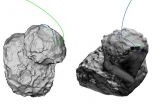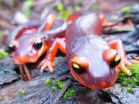Special issue: Philae results shed light on the nature of comets
2015-07-30
(Press-News.org) This news release is available in Japanese.
During the first ever landing of a probe on a comet, the world held its breath as Philae survived a bouncy landing on comet 67P/Churyumov-Gerasimenko on November 12, 2014. This special issue of Science highlights seven new studies that delve further into the data that has been transmitted back by Philae. In a detailed account, Jens Biele et al. describe the critical moments where Philae descends on 67P, only to bounce off the soft, intended landing area and finally settle on a harder surface farther away. Analysis of the different compressive strengths of the two surfaces, based on the bouncing trajectory, sheds more light on the evolution of comets and could improve the design of future comet missions. Previously, scientists trying to understand comet surface material strength had to rely on indirect observations, which have ranged widely, and include some very low values that have raised questions about whether a comet could successfully dock on such weak material. After analyzing the depth profile of the lander footprint features with imaging tools, Biele and colleagues believe that the Philae's feet first came in contact with a soft granular surface, which was approximately 0.25 meters (0.82 feet) thick, with a harder layer below. This layering creates a compressive strength of about 1 kilopascal, whereas the compression strength of Philae's final, much harder landing site exceeded 2 megapascals (2,000 kilopascals), possibly contributing to why only one leg was able to anchor to this latter surface, and partially at that.
In a research article by Wlodek Kofman et al., the team found the composition of the head of the comet to be fairly homogenous. To get a better idea of 67P's interior, the team directed electromagnetic signals through the nucleus of the comet to Rosetta on the opposite side. The signals Rosetta received lacked a scattering pattern, indicating that the interior of the comet is uniform throughout. The team used these electromagnetic measurements, which analyze the permittivity (resistance of the electrical field), to further determine that 67P has dust/ice ratio of 0.4 to 2.6 and a very high porosity of 75 to 85%. Research by Fred Goesmann and colleagues further analyzes the composition of 67P using the COmetary SAmpling and Composition (COSAC) instrument, designed to identify organic compounds in the comet and thus contribute to a deeper understanding of the history of life on Earth (some scientists think comets delivered to Earth materials that were important for its chemical and biological evolution). The device collected molecules from 10 kilometers (6.2 miles) above the comet surface, after the initial touchdown, and at the final resting site. This process detected 16 organic compounds, four of which - methyl isocyanate, acetone, propionaldehyde, and acetamide - were previously unknown to exist on comets. In a related study, Ian Wright et al. also analyzed organic compounds on 67P but used Ptolemy, an instrument that measures stable isotope ratios. Their measurements indicate the presence of a radiation-induced polymer on the surface of the comet. Ptolemy measurements also indicate an absence of aromatic compounds, such as benzene, on the comet.
In a study by Jean-Pierre Bibring and colleagues, the surface of 67P is analyzed in panoramic images taken by a set of seven cameras as part of the Comet Infrared and Visible Analyser (CIVA). The collection of images, taken just after Philae's initial bounce and final touchdown, reveal a fractured surface with a variety of grain scales and reflective rock structures, offering unprecedented insights into this type of primitive space matter. As Philae approached 67P, far-field sequence and the near-field sequence images revealed a clearer picture of the comet's geography; an analysis of Rosetta Lander Imaging System (ROLIS) descent images by Stefano Mottola et al. suggests that 67P's landscape is shaped by erosion. Boulders jutting out of granular areas are surrounded by depressions that are reminiscent of the wind tails observed on Earth, the result of wind erosion and deposition. The authors speculate that some of the erosion occurs from "splashing", the ejection of one or more soil particles by the impact of an incoming projectile, which they confirmed using models. Finally, to determine 67P's thermal and mechanical properties, Tilman Spohn and colleagues analyzed data from Multi Purpose Sensors for Surface and Subsurface Science (MUPUS) thermal and penetrating sensors on board Philae. Due to the lander's unintentional final resting spot, the sensors were unable to penetrate the hard surface to attain subsurface temperature readings; however, the data reveals that 67P's daytime surface temperature varies between 90 and 130 Kelvin. By analyzing thermal inertia and soil composition, the team found that the surface at the final landing spot is covered with a highly compact, microporous, dust-ice layer with a porosity of 30 to 65%. Collectively, the unique data that Philae has sent back brings us closer than ever before to understanding the nature of comets.
INFORMATION:
News Story from Science: A related news article by Eric Hand will be available on Wednesday, 29 July.
Article #10: "The landing(s) of Philae and inferences about comet surface mechanical properties," by J. Biele; S. Ulamec; M. Maibaum; C. Fantinati; F. Finke; H.-H. Fischer; K. Geurts; V. Lommatsch at German Aerospace Center (DLR) in Cologne, Germany; L. Witte at German Aerospace Center (DLR) in Bremen, Germany; R. Rol; C. Güttler; H. Sierks at Max-Planck-Institut für Sonnensystemforschung in Göttingen, Germany. For a complete list of authors, see the manuscript.
ELSE PRESS RELEASES FROM THIS DATE:
2015-07-30
This news release is available in Japanese.
By studying how water striders jump on water, Je-Sung Koh and colleagues have created a robot that can successfully launch itself from the surface of water. As the team watched the water strider jump on water surfaces using high-speed cameras, they noticed that the long legs accelerate gradually, so that the water surface doesn't retreat too quickly and lose contact with the legs. Using a theoretical model of a flexible cylinder floating on liquid, the authors found that the maximum force of the water striders' legs is always ...
2015-07-30
This news release is available in Japanese.
The international pet trade threatens to spread a deadly fungal infection to North America's rich wild salamander population and must be frozen, according to the authors of this Policy Forum. Batrachochytrium salamandrivorans (Bsal) is a highly virulent, often fatal fungus that infects salamanders, and there is no effective way to control it after it infects a wild population, say Tiffany Yap and colleagues. It is theorized that Bsal started in Asia and spread to wild European salamanders via the international pet ...
2015-07-30
SAN FRANCISCO, CA - July 30, 2015 - A study released today at the Society of NeuroInterventional Surgery 12th Annual Meeting in San Francisco, California, indicates that strict adherence to two commonly-used tools to weigh the risk of treating unruptured aneurysms may not prevent the majority of morbidity-mortality outcomes associated with ruptured intracranial aneurysms. Thus, the International Study of Unruptured Intracranial Aneurysms (ISUIA) criteria and the PHASES score require additional research to determine their effectiveness.
Published in 2003, the ISUIA study ...
2015-07-30
Boston, MA -- New research from Harvard T.H. Chan School of Public Health describes a molecular mechanism that helps explain how obesity-related inflammation can lead to type 2 diabetes. The findings describe a surprising connection between two molecular processes that are known to be involved in the development of metabolic disease--inflammation and endoplasmic reticulum (ER) dysfunction--and suggest that targeting this connection could aid in the development of new therapies.
The study will be published in the July 31, 2015 issue of Science.
Specifically, the researchers ...
2015-07-30
Scientists have long worked to understand how crystals grow into complex shapes. Crystals are important in materials from skeletons and shells to soils and semiconductor materials, but much is unknown about how they form.
Now, an international group of researchers has shown how nature uses a variety of pathways to grow crystals that go beyond the classical, one-atom-at-a-time route.
The findings, published today (Thursday, July 30) in Science, have implications for decades-old questions in science and technology regarding how animals and plants grow minerals into shapes ...
2015-07-30
IgA deficiency is one of the most common genetic immunodeficiency disorders in humans and is associated with an insufficiency or complete absence of the antibody IgA. Researchers led from Uppsala University and Karolinska Institutet in Sweden have now performed the first comparative genetic study of IgA deficiency by using the dog as genetic disease model. Novel candidate genes have been identified and the results are published in PLOS ONE.
People with low IgA are at higher risk for developing recurrent infections, allergies and autoimmunity. The underlying genetic factors ...
2015-07-30
Highly active anti-retroviral therapy (HAART) has helped millions survive the human immunodeficiency virus (HIV). Unfortunately, HIV has a built-in survival mechanism, creating reservoirs of latent, inactive virus that are invisible to both HAART and the immune system.
But now, researchers at UC Davis have identified a compound that activates latent HIV, offering the tantalizing possibility that the virus can be flushed out of the silent reservoirs and fully cured. Even better, the compound (PEP005) is already approved by the FDA. The study was published in the journal ...
2015-07-30
(SEOUL and BOSTON) - The concept of walking on water might sound supernatural, but in fact it is a quite natural phenomenon. Many small living creatures leverage water's surface tension to maneuver themselves around. One of the most complex maneuvers, jumping on water, is achieved by a species of semi-aquatic insects called water striders that not only skim along water's surface but also generate enough upward thrust with their legs to launch themselves airborne from it.
Now, emulating this natural form of water-based locomotion, an international team of scientists from ...
2015-07-30
A study by researchers at the National Institute of Allergy and Infectious Diseases and Duke University helps explain why the candidate vaccine used in the HVTN 505 clinical trial was not protective against HIV infection despite robustly inducing anti-HIV antibodies: the vaccine stimulated antibodies that recognized HIV as well as microbes commonly found in the intestinal tract, part of the body's microbiome. The researchers suggest that these antibodies arose because the vaccine boosted an existing antibody response to the intestinal microbiome, which may explain why ...
2015-07-30
Washington -- Thousands of nonhuman primates continue to be confined alone in laboratories despite 30-year-old federal regulations and guidelines mandating that social housing of primates should be the default. A new article co-authored by PETA scientists and Marymount University researchers, published in Perspectives in Laboratory Animal Science, argues that many laboratories cage primates alone--a harmful practice often done for convenience--and that the U.S. government isn't doing enough to address this growing problem.
Decades of research shows that housing highly ...
LAST 30 PRESS RELEASES:
[Press-News.org] Special issue: Philae results shed light on the nature of comets




